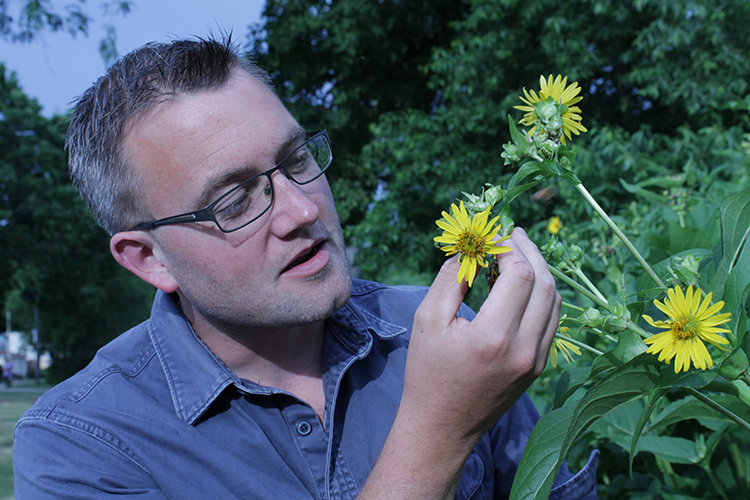Ben Habanek is the village horticulturalist of Shorewood, Wisconsin. Although his job description includes the natural standbys like planting flowers and shrubs, Habanek is also responsible for making residents think about the importance of sustainability in their own backyards.
He sat down to talk about his job – and how to make people care about the green spaces around them.
How did you become a village horticulturist?
I completed an associate degree in landscape horticulture from Milwaukee Area Technical College and decided that I wanted to continue on to a bachelor’s degree. Initially I went to UWM for education to be a science teacher. As part of that program, I had to take some conservation and environmental science classes, and it just sucked me in. I switched my major and got my BS in CES in 2013. After I finished, I worked at Boerner Botanical Gardens with Milwaukee County Parks, and then had the opportunity to come work for the village of Shorewood. I’ve been here for six months.
What does a municipal horticulturist do?
The question is, what don’t I do? My official title is horticulturist/forester. I assist the forestry crew with street tree work, assist with other Department of Public Works tasks, and in the winter I’m on call for snow removal. Every once in a while, I’m lucky enough to drive a garbage truck for the day. You’ll never know quite what you’ll be asked to do.
Most of the time, my job duties are related to the green space in the village. We have a couple of parks; they’re small but well-loved and get a lot of use. I oversee those, as well as all of the greenspace around our village hall, library and police station. I also design, install and maintain about 125 street planters that you’ll see out by the bus stops and up and down the main artery roads in the village.
For some people, those planters and parks are the most exposure they’ll get to nature.
That’s true. Not a lot of people realize this, but Shorewood is the most densely populated community in the state of Wisconsin. A person’s daily interaction with nature may be reduced down to having a butterfly land on a flower in a planter next to the bench they’re sitting on while they wait for the bus.
Those opportunities to reach people who don’t have nature as a big part of their life and get them to think and care about things like butterflies and birds are the opportunities that I work to seize.
Why is it important that people care about that kind of stuff?
That’s a pretty complex issue, but I think it’s clear that it does really matter. When you have spaces for people to come out into the community and connect with the natural world, you’re making life better for citizens of urban environments. Those small connections that develop when they’re in these urban greenspaces get people thinking about things like water quality, pesticide usage and the garbage they throw away. It doesn’t take much for someone to change the way that they think.
It’s no secret that having accessible greenspace relates to an improved quality of life, reduced crime and, in general, a better life for inhabitants of urban communities. Humans weren’t born to spend their entire life on concrete.
What role do municipalities play in managing the ecosystems of a community?
Moving forward, you’re seeing new projects replace crumbling infrastructure, with a modern focus on green infrastructure. You’re seeing things like bioswales, native plantings and a different approach to the management of runoff water and open space in general.
The design style and associated maintenance of these new features can have a big impact on the relative health of the local ecosystem, and municipalities have to treat this differently than they used to. You can’t just channel all of your runoff into the river anymore. The quality of the environment going forward for the next generation is dependent on the thought process that we use now.
What’s the best part about being a municipal horticulturist?
It’s when you see people connect with the work you’ve done. When I see schoolchildren pulling out their cell phones and taking pictures of a butterfly on a flower that I planted, I’m gratified. I’ve given them something that they’re going to take with them for the rest of their day and hopefully it can bloom into something more and affect their decision-making going forward in the rest of their life.








